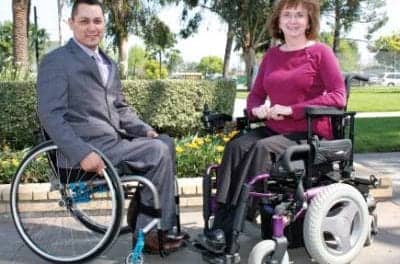by Ann Eubank, LMSW, OTR/L, ATP, CAPS
Rehab clinicians are typically good-natured and quite principled working in a system with tight oversight on almost every aspect of our jobs. We must chart patient progress to ensure insurance entities reimburse our billable hours, we must be on time—every day—and provide appropriate treatment. Yet, our professional ethics may be challenged more than we realize.
We are characteristically rule-followers, and for the most part, that is a good thing. Yet, we work within a system that doesn’t necessarily embrace the ethical principles of our professional licensing boards. For instance, when a client requires a wheelchair to live her/his life, the first question typically asked is about the insurance guidelines regarding wheeled mobility. If the insurance rules state there is a $2000 limit to fund a wheelchair, we tell the client she/he “qualifies” for a really inexpensive wheelchair, and to make the best of it.
Let’s take a look at our ethics, remember those? As licensed professionals we must meet educational requirements along with professional standards, practicing within clinical guidelines. The license allows for oversight, it provides the licensing board with the power to revoke an unethical clinician’s license, therefore denying the right to practice within a specific state. Because we have an overseeing regulatory body, our profession is accountable. Our professional ethics mandate that we provide the best treatment possible to all patients regardless of our personal beliefs. Our professional ethics even state that we need to sustain an awareness of the health needs of our society. Occupational therapy ethics go so far as to say: “occupational therapy personnel shall respect the right of the individual to self-determination.” Occupational therapy’s ethics also incorporate the concept of veracity, stating, “Veracity is based on the virtues of truthfulness, candor, and honesty.” I take that to mean we are supposed to tell clients the whole truth. The veracity construct reinforces the concept of respecting an individual’s right to self-determination. We learned about this, it’s called “client-centered practice.”
We already established that as people we are generally kind, altruistic rule-followers. Our professional ethics do not state that we “protect” clients from the truth because it may be overwhelming, or their insurance won’t cover the recommended treatment or product, so it’s best not to upset them more. No, we are ethically bound to educate clients about all options.
We work within multiple systems, each adopting rules and strategies to ensure their success (profit). Our ethics may be challenged when a clinical outcome from a professional and client perspective differs from that of the insurance entity, or possibly the institution. It is possible that some clinicians, while submitting to the system’s rules, may inadvertently act contrary to their professional ethics. Do we serve the client or the insurance company?
Here is an ethical scenario: a clinician provides treatment to individuals who will be discharged using a wheelchair to live their lives to the fullest. The clinician has basic working knowledge of wheeled mobility, but don’t consider herself or himself an expert. The clinician is pleased there are a few wheelchair suppliers in the area who call on the center and participate in the wheelchair evaluations. (Here is where the ethics may get fuzzy.) This clinician is very knowledgeable about the client’s diagnosis, ADL status, balance abilities and prognosis, yet is not sure of the specific wheelchair options. Question: should the clinician be up to date about all the wheelchair options? Answer: No, the clinician’s job is to run the wheelchair evaluation and be sure to work with the client to choose the best possible solution. It is the clinician’s responsibility to: match the technology to the client’s functional and medical need, ask questions of the supplier about why certain products are—or are not—available. The clinician should also see the wheelchair acquisition process all the way through to delivery. Yes, the clinician should be present at the time of delivery.
Ethically speaking, the clinician is there for the client’s goals. The cliniciab us not there to fulfill the rehab center’s goal of using a specific supplier, not the insurance company’s goal of using only the cheapest equipment possible, and not the supplier’s profit margin. There is much to consider, there is always much to consider. Who is your first priority?
Your license is on the line if you allow a non-licensed professional to perform the final delivery alone. It is highly recommended to work only with certified wheelchair suppliers. The certification is called “assistive technology professional” or ATP. Clinicians may also attain this certification, showing a number of years’ experience prescribing wheelchairs and passing a test. The ATP or SMS certification is a way to recognize formal, advanced practice skills and knowledge about seating and wheeled mobility.
Yet, even with this certification, the wheelchair supplier profession does not yet have a license. It’s not their fault, after all OT began as a certificate program. But, without a license, there is virtually no oversight of the wheelchair process once it is in the hands of the supplier. He/she may have years and years of experience, have exhibited excellent clinical judgment and may even have a clinical background, but the profession does not have a license. The professional with the license is ultimately responsible for the client’s outcome with the assistive technology. For example, if a supplier delivers the equipment to the home without the prescribing clinician present, and a month afterward the client reports a pressure wound due to ill-fitting equipment, who will be held accountable? Answer: the professional who has a license.
I am not accusing anyone of anything, I am just offering up some old-fashioned advice as an old dog OT and wheelchair geek and lover. To learn more about the wheelchair process (every step), you can go to the UsersFirst Mobility Map. And, while you are there, register and follow us on Facebook so you can stay connected to these types of topics. Please feel free to contact me, I would love to hear from you – [email protected]






